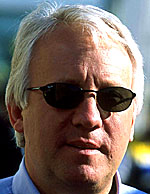 With the Formula One teams beginning their development programmes for the upcoming season, Charlie Whiting (right) provides an overview of the main regulation changes and their implications.
With the Formula One teams beginning their development programmes for the upcoming season, Charlie Whiting (right) provides an overview of the main regulation changes and their implications.
Revised Aerodynamics
What was the idea behind all the changes we'll see this year in this area?
Charlie Whiting: This was all a result of the work done by the Overtaking Working Group, as it was called, made up of the technical directors of Renault, Ferrari and McLaren, plus myself. After a lot of research, we came up with a package that gave a following car less disturbance and would make overtaking less difficult.
The key element of this is, first of all, a neutral section of the front wing (the middle half metre of this device is a prescribed section). The incidence of that profile and its position relative to the reference plane are carefully prescribed. It's the most critical part. The front wing is wider and there are no turning vanes or bargeboards: the area where you can put them has been severely restricted, because there's only room for very small devices.
Also, the diffuser has been made smaller, and the rear wing is higher but narrower. I can't go into the specifics of why these things were done, but we arrived at this package by five sessions of wind tunnel work. It's been carefully thought through. Now, we'll have to wait and see how it works on the track.
What has been the loss in terms of downforce of these measures?
CW: The target figure was 50% less. But, as ever with these things, one never knows how much the engineers have managed to claw back.
Have some unexpected devices already appeared on the new cars?
CW: You know, we write the rules to enable the teams to design cars as close as possible to the technical spec. They've been working in areas they hadn't previously been trying to work in, so there's not much we can do about that. I'm confident we've achieved a fairly significant reduction in downforce, but that's not the critical thing: the critical thing is the effects. As long as we have the effects, we should be okay.
Slick Tyres
Presumably, these effects have to be considered in conjunction with the slick tyres...
CW: Yes. An increase in mechanical grip and a decrease in aero grip were what we wanted. We' should achieve 6 to 8% more mechanical grip with slick tyres, but it'll clearly depend on the compound because Bridgestone will provide a range of tyres -4 different ones to be exact. They are still developing these, so we don't know exactly how it's going to work out.
Is it true to say that Bridgestone is working on a bigger gap between the available compounds at each race?
CW: Yes. This year, once again, each driver will have to use two different types of slick tyres during the race. We wanted to have a bigger difference between them. Sometimes, in 2008, this gap was a matter of one or two tenths. We thought it would be better if it was bigger. The Bridgestone engineers are working on that.
There seems to have been some talk during the winter tests about this difference being massive…
CW: What happens in winter testing is probably not indicative of what will happen in the warmer conditions of the first four races. It's something we'll have to look at, as we certainly don't want too big a difference between the two types of tyres available at each race. This said, I think it would be to everyone's benefit if there were a slightly bigger gap.
What would be this ideal gap?
CW: My personal opinion is at least half-a-second. But it's only a personal opinion. Sometimes, in 2008, the difference between the two types of tyres was negligible wasn't it? One couldn't see the difference between the two, really.
KERS Systems
A lot of teams seem just about ready to use their KERS system now. Is it worrying?
CW: The reason for KERS is very clear. We want to showcase technology. I think F1 using this sort of system will help manufacturers. Obviously, Formula 1 is going to be doing something to speed up the development pace on road cars. The other thing, obviously, is overtaking. For a driver to be able to use the extra horsepower at his disposal for overtaking has, I think, the potential to improve racing and that's what we're hoping for.

 With the Formula One teams beginning their development programmes for the upcoming season, Charlie Whiting (right) provides an overview of the main regulation changes and their implications.
With the Formula One teams beginning their development programmes for the upcoming season, Charlie Whiting (right) provides an overview of the main regulation changes and their implications.



















sign in